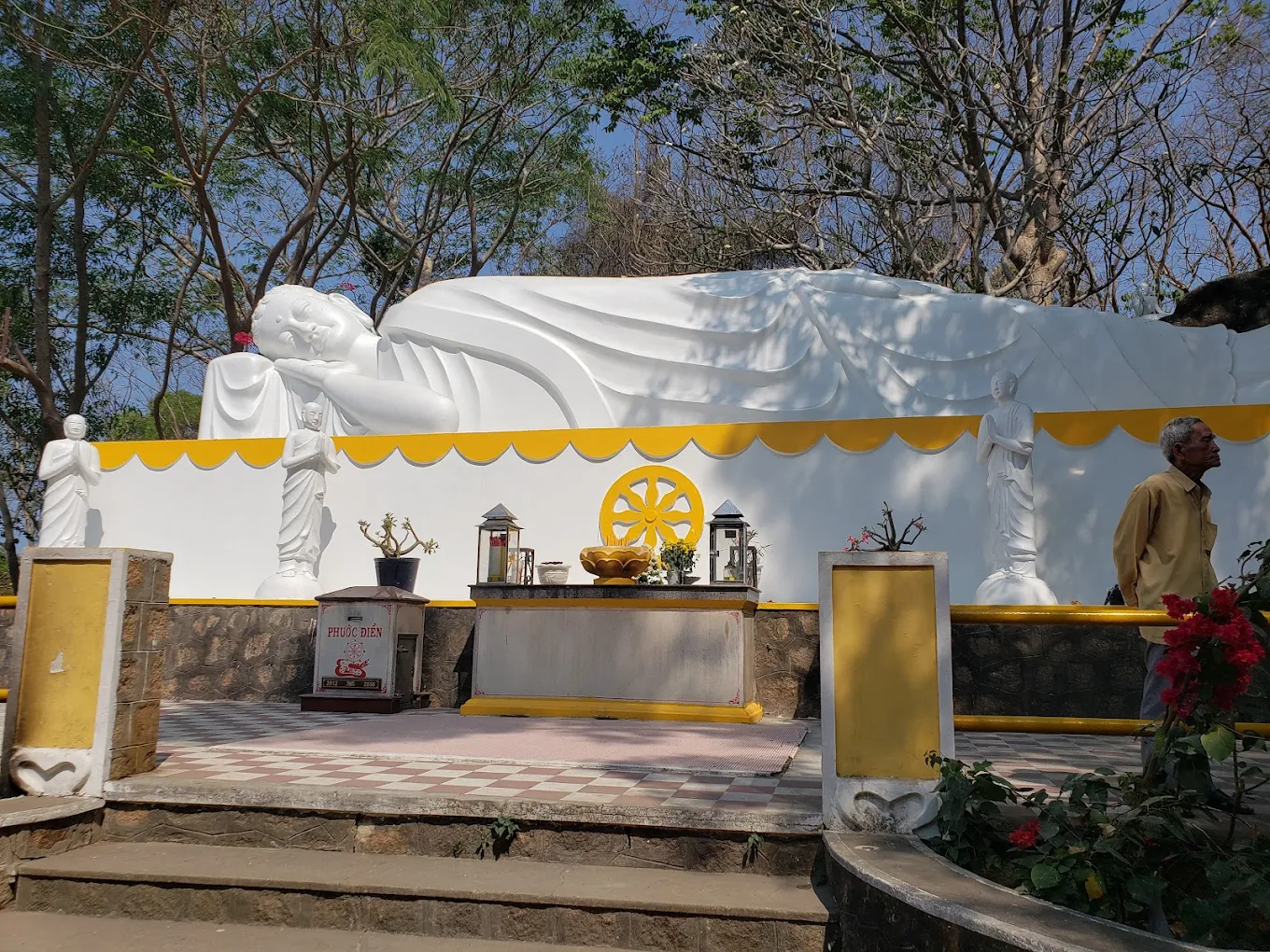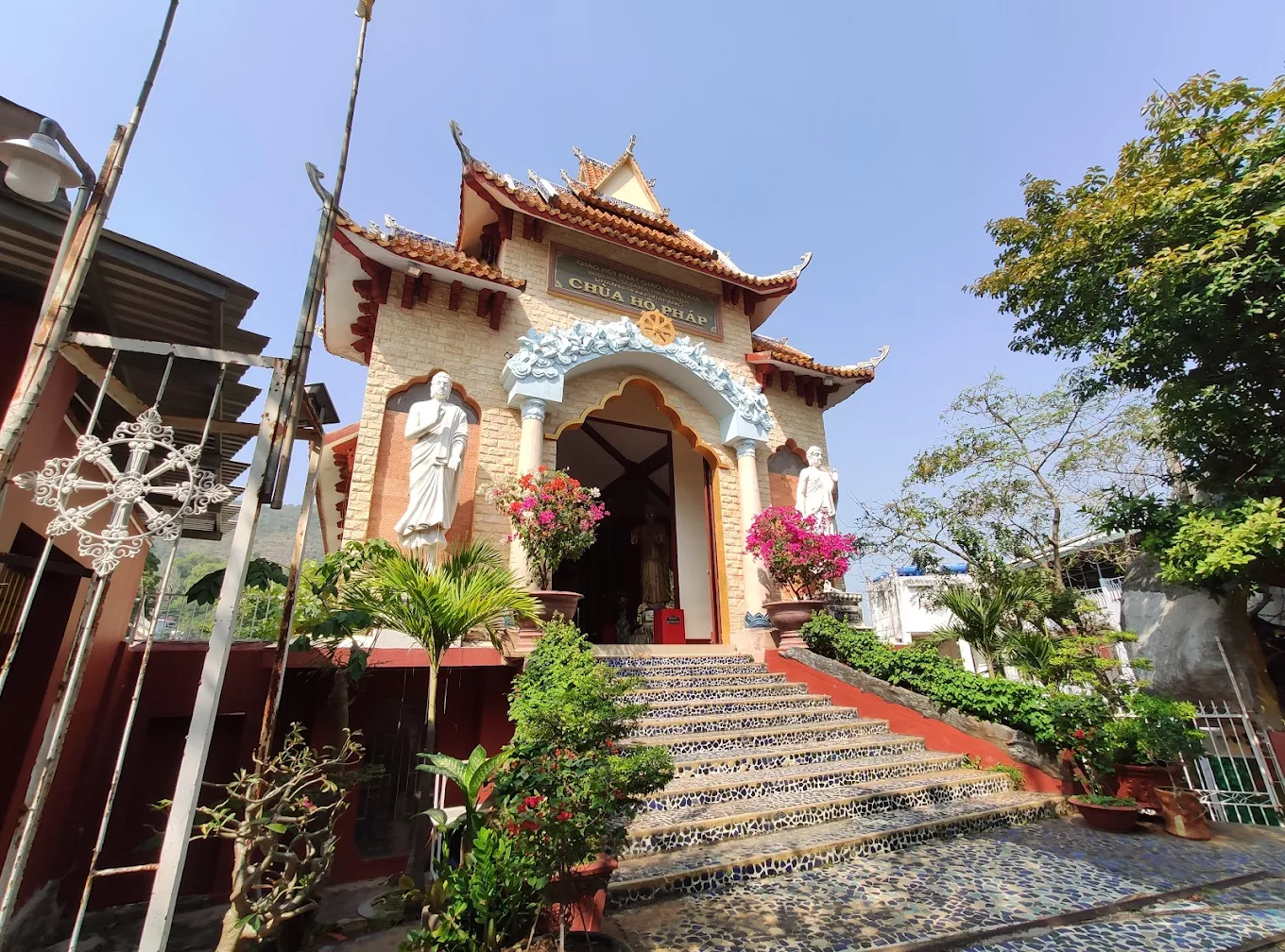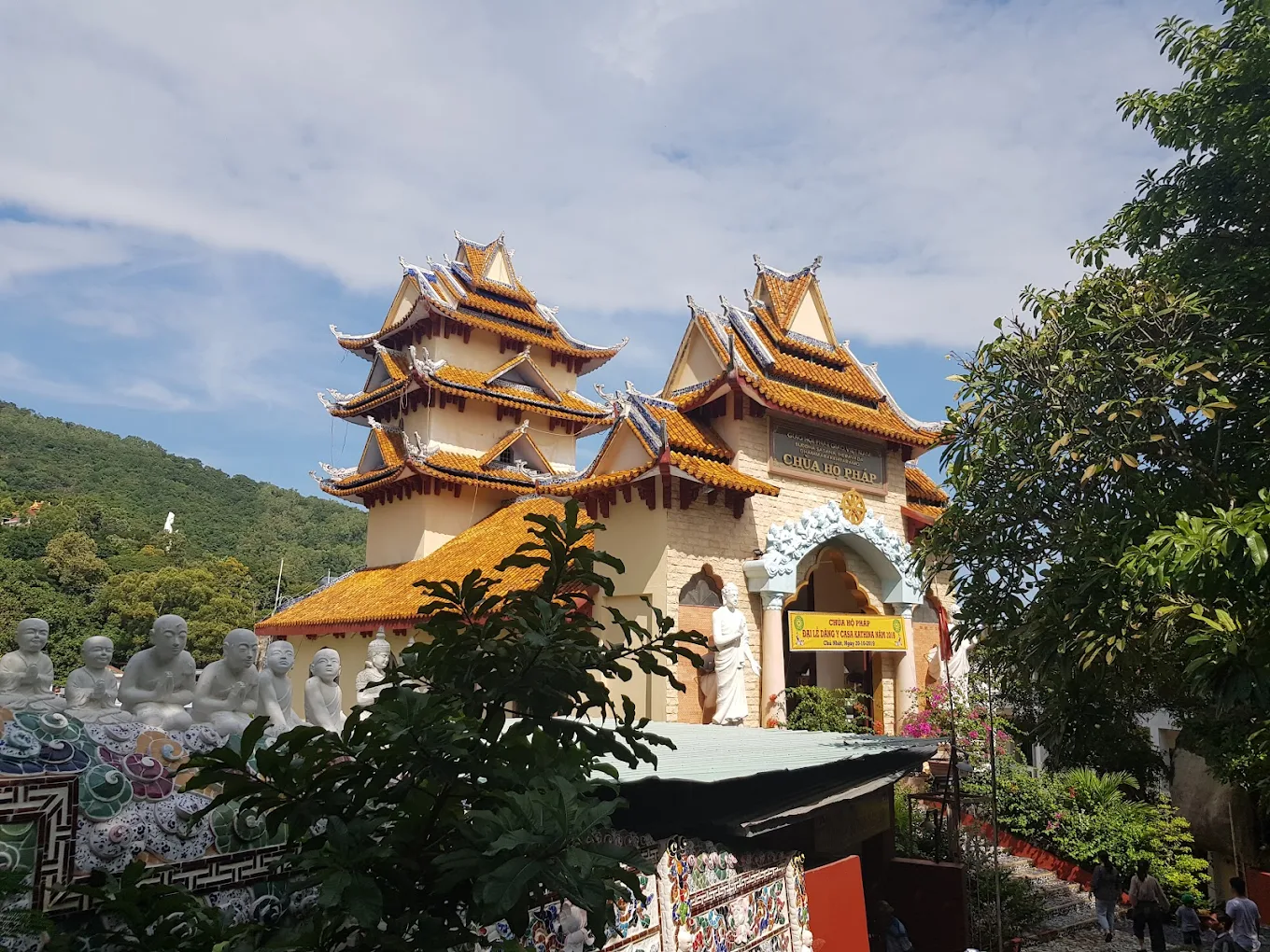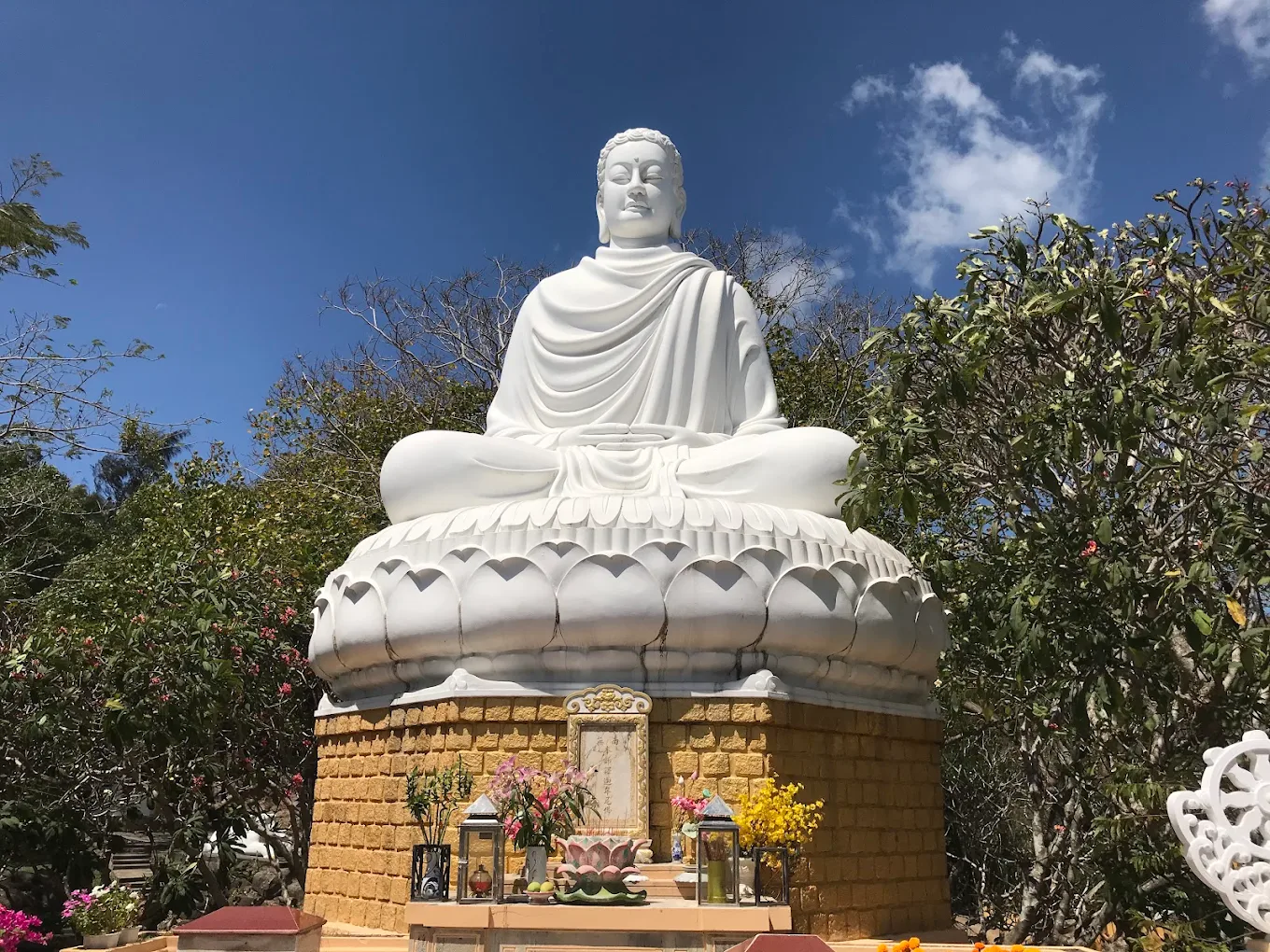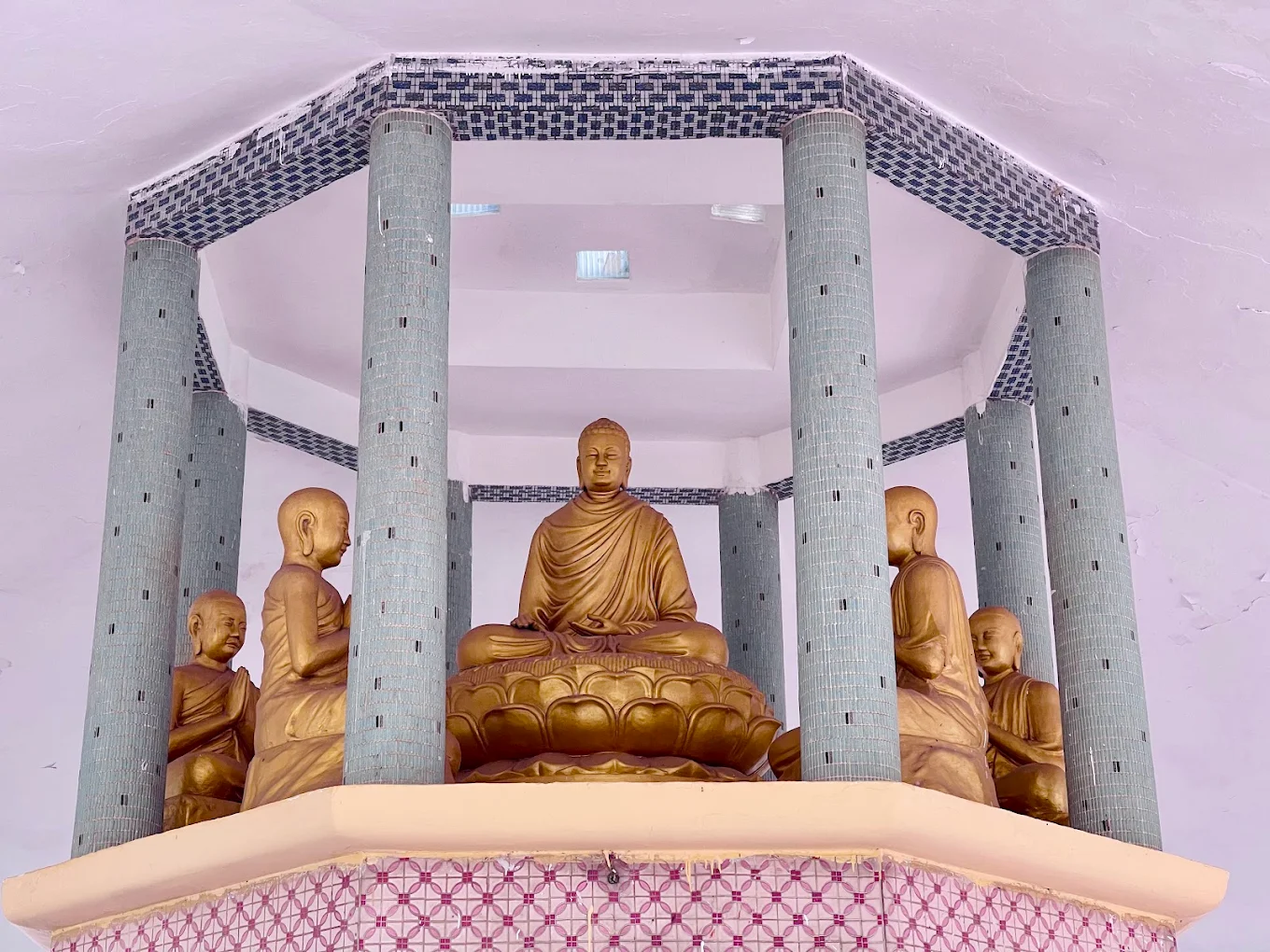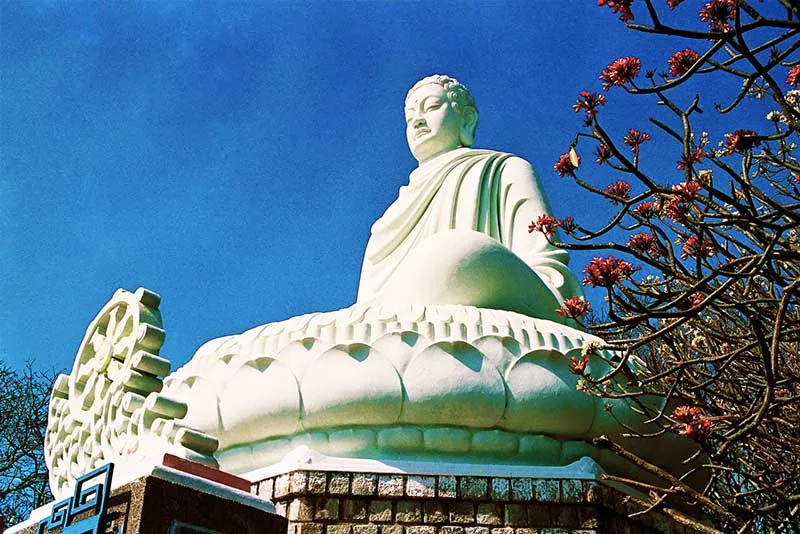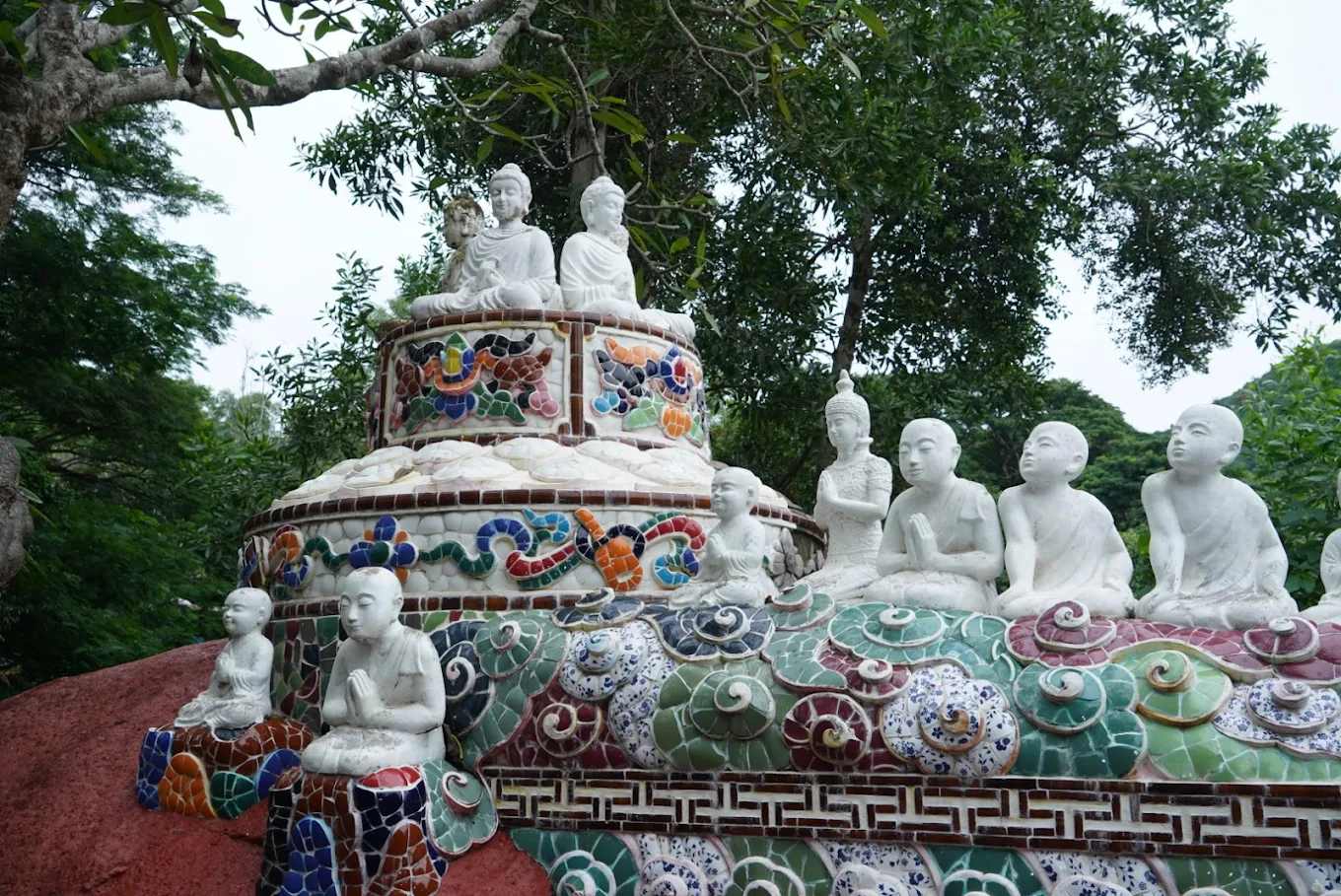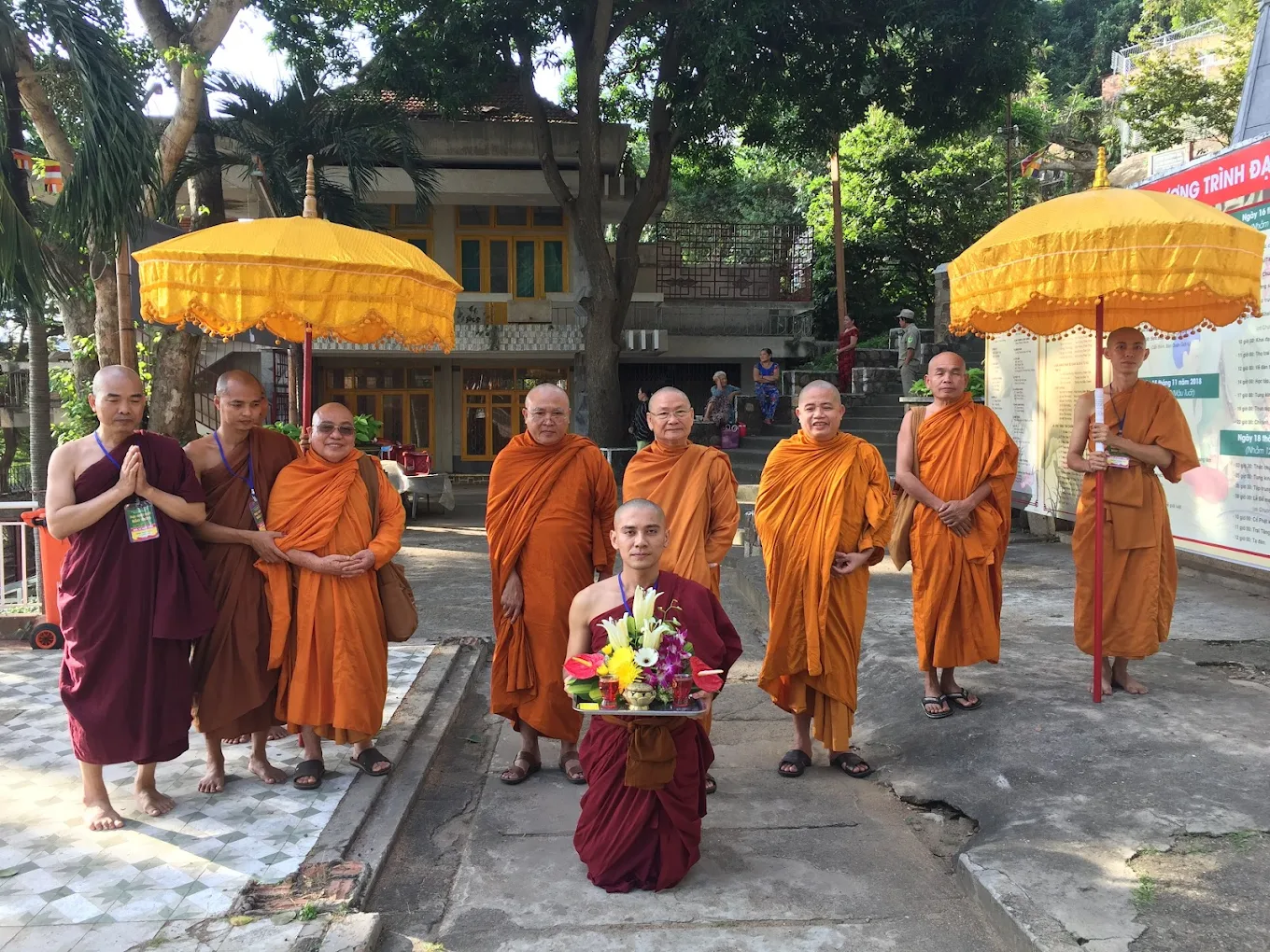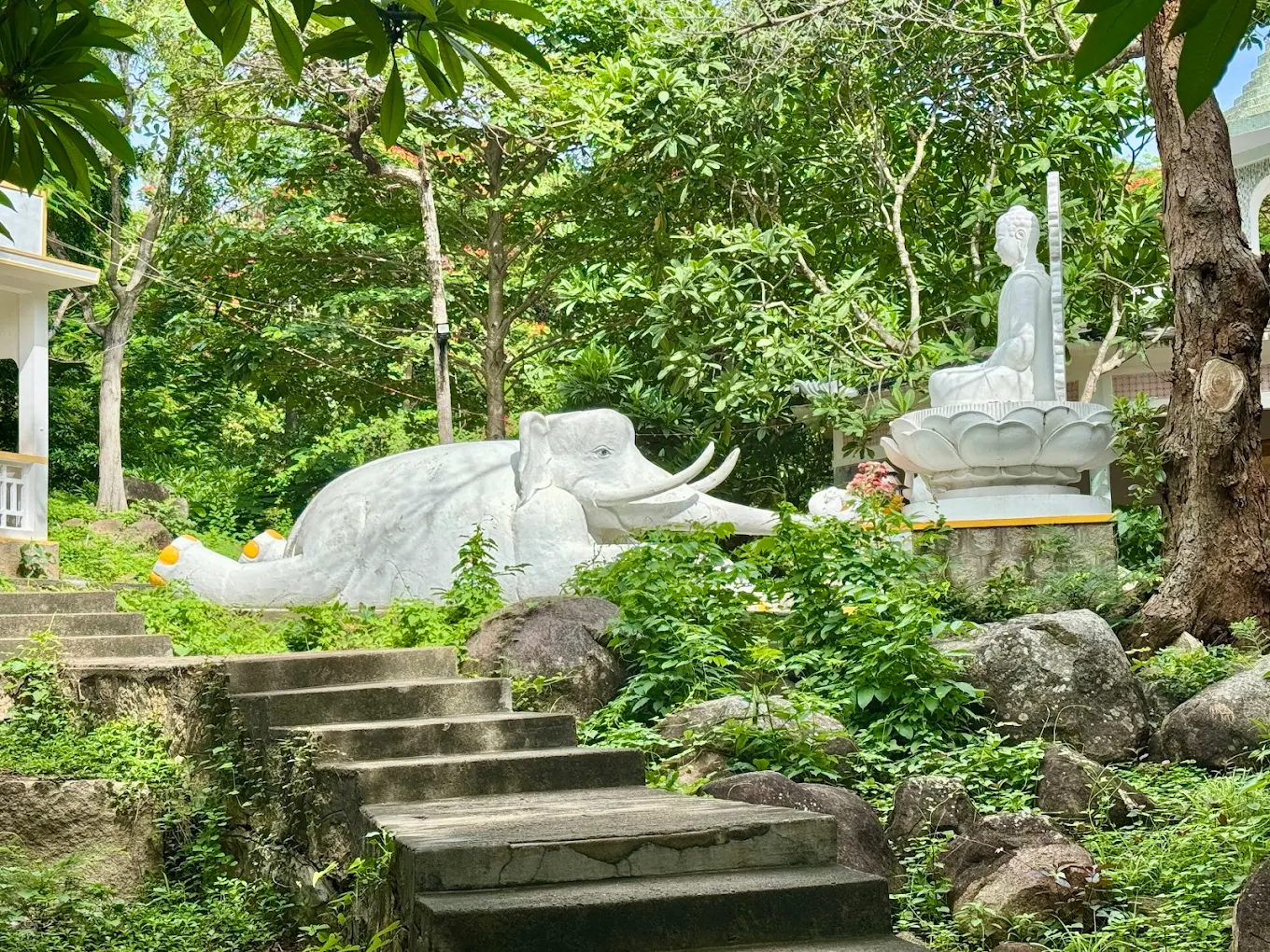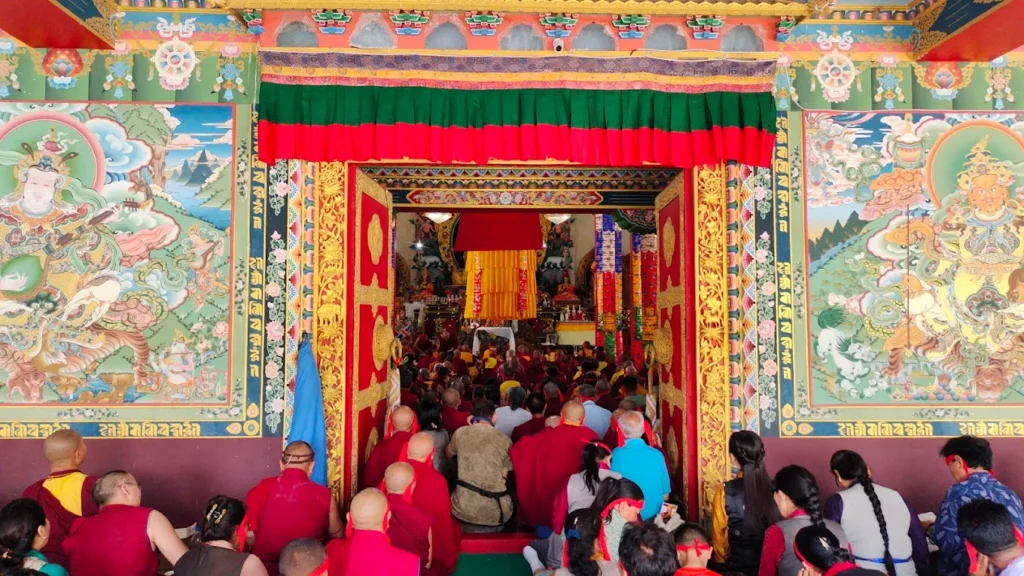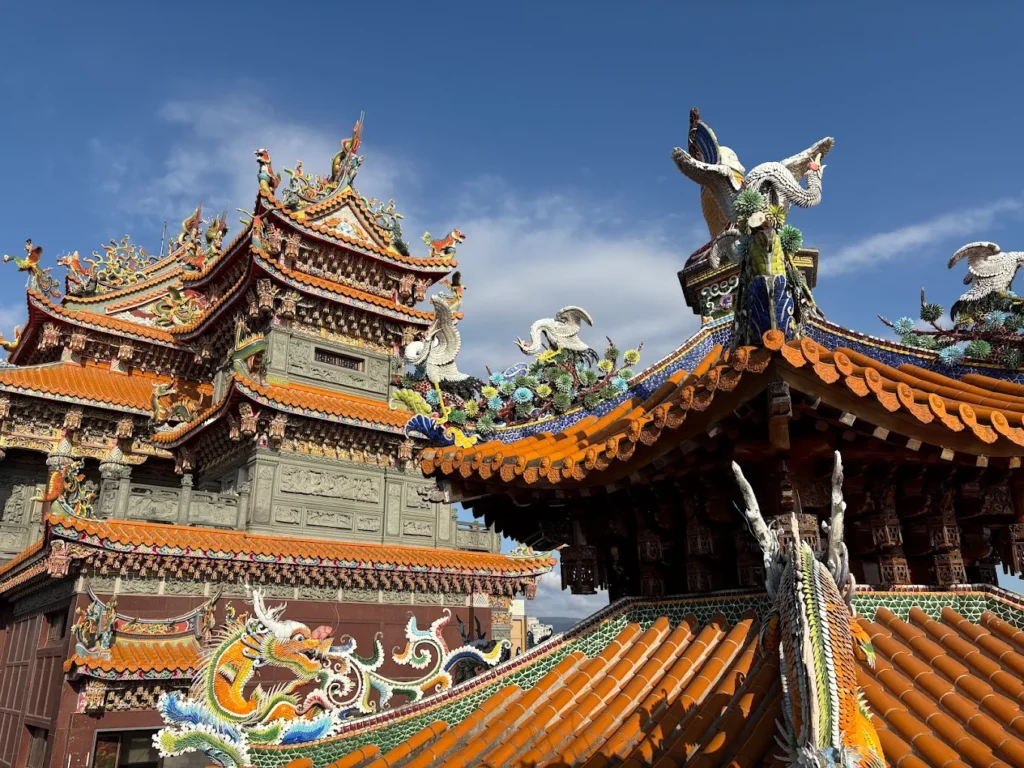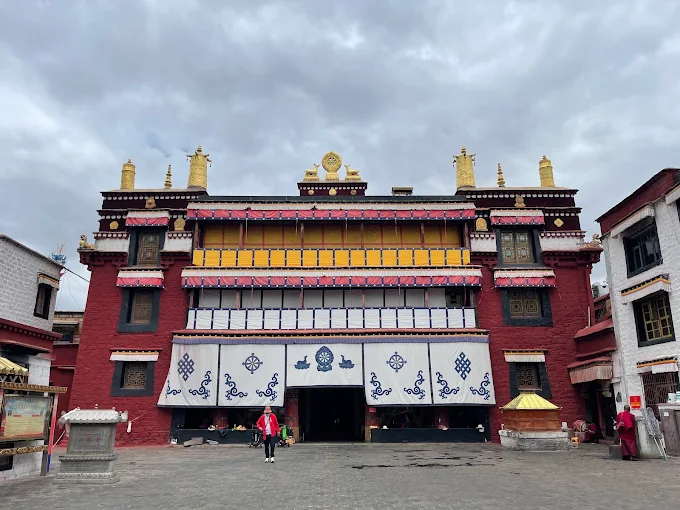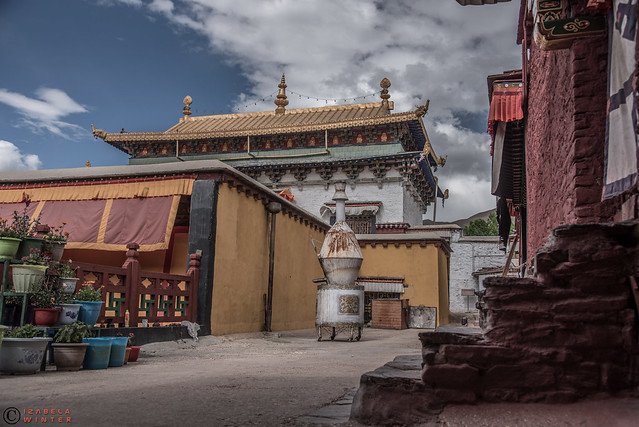Thich Ca Phat Dai Pagoda: The Mountain Majesty of Vietnam’s Buddhist Saga
As dawn crests over Vũng Tàu’s Large Mountain, Thich Ca Phat Dai Pagoda awakens, its sprawling 28-hectare complex aglow, where the towering Shakyamuni Buddha statue gazes serenely across the East Sea. The air hums with Amitabha chanting, devotees seeking rebirth in Amitabha’s Western Paradise, their voices weaving with sandalwood incense and the rustle of bodhi leaves in the Lumbini Garden. A lotus bloom sways in a tranquil pond, mirroring the Xá Lợi Stupa’s silhouette, a masterpiece of Vietnamese artistry. This Mahayana sanctuary, Vũng Tàu’s largest, invites all to trace Buddha’s life through its sacred paths and coastal vistas.
Overview and Significance
Introduction to Thich Ca Phat Dai Pagoda
Thich Ca Phat Dai Pagoda, perched on the slopes of Large Mountain (Núi Lớn) in Vũng Tàu, stands as the city’s grandest Mahayana Buddhist temple, its 6-meter Shakyamuni Buddha statue and sprawling 28-hectare complex embodying the serenity of the Pure Land tradition, which centers on devotion to Amitabha Buddha for rebirth in his Western Paradise. Located 3 kilometers from Vũng Tàu’s city center at 608 Trần Phú, this 1961-founded sanctuary blends East Asian elegance with Vietnamese architectural designs, offering panoramic coastal views. Its monumental stupa, lush gardens depicting Buddha’s life, and vibrant Vesak festivals make it a cultural cornerstone, drawing pilgrims, tourists, and scholars into a realm of spiritual majesty.
Historical Journey
Founded between 1961 and 1963 under the guidance of Venerable Thích Thiện Hoa, Thich Ca Phat Dai Pagoda emerged as a spiritual haven for Vũng Tàu’s Mahayana community, built with donations from local devotees. Designed to recreate key moments of Buddha’s life, the complex includes gardens like Lumbini and Sarnath, reflecting his birth and enlightenment. The 17-meter Xá Lợi Stupa, housing 13 relics of enlightened monks, was completed in 1963, marking a milestone. Renovations in the 1990s enhanced its meditation halls and pathways, ensuring accessibility.
Through Vũng Tàu’s growth as a coastal resort, the pagoda has remained a serene retreat, its history a testament to Buddhist devotion and community spirit.
- Patronage: Supported by local Mahayana Buddhists and Vietnam Buddhist Sangha.
- Milestones: Founded 1961–1963; Xá Lợi Stupa completed in 1963; renovated in 1990s.
Cultural Significance
Thich Ca Phat Dai Pagoda is a vital hub for Vũng Tàu’s Mahayana community, fostering devotion to Shakyamuni Buddha and Avalokitesvara. Its Pure Land practices, centered on Amitabha chanting, offer solace to devotees and fishermen seeking protection. The pagoda hosts cultural events, like Vesak festivals and peace-praying ceremonies, drawing thousands to its mountain paths.
Regionally, it connects with Mahayana communities across Vietnam, sharing Pure Land teachings. Globally, it attracts scholars studying Vietnamese Buddhist architecture and tourists drawn to its coastal vistas and garden narratives, offering a glimpse into Mahayana’s compassion.
- Mahayana Hub: Preserves Pure Land practices in Vũng Tàu.
- Cultural Role: Hosts Vesak festivals and peace-praying ceremonies.
- Global Appeal: Attracts scholars and tourists for its gardens and views.
Unique Legacy
The pagoda’s vast complex and Shakyamuni Buddha statue define its legacy, embodying Mahayana’s grandeur. The 28-hectare grounds, with gardens recreating Buddha’s life, and the 17-meter Xá Lợi Stupa symbolize enlightenment’s journey. Vietnamese lotus motifs and stone carvings reflect local syncretism, while statues like Avalokitesvara anchor spiritual devotion.
This fusion of monumental architecture, spiritual statues, and narrative gardens earns Thich Ca Phat Dai Pagoda its title as the “Mountain Majesty of Vietnam’s Buddhist Saga,” a living testament to Buddha’s path.
- Shakyamuni Statue: 6-meter icon on lotus throne.
- Xá Lợi Stupa: 17-meter relic tower.
- Cultural Syncretism: Vietnamese Mahayana influences.
Community and Global Impact
Thich Ca Phat Dai Pagoda thrives as a communal heart for Vũng Tàu’s Buddhist community. On lunar days, devotees ascend its paths to chant before the Shakyamuni Buddha statue, their prayers echoing across the mountain. Charity drives, supporting local fishermen, strengthen community bonds, while Vesak festivals draw thousands with lantern processions and offerings to Avalokitesvara.
Globally, the pagoda hosts Buddhist exchanges, welcoming Vietnamese monks and scholars. The Vietnamese diaspora supports maintenance, reinforcing cultural ties. Its coastal setting and narrative gardens cement its global role as a Mahayana sanctuary.
- Local Engagement: Hosts prayers, charity, and festivals.
- Global Reach: Draws monks and scholars from Vietnam.
- Diaspora Support: Funded by Vietnamese communities abroad.
Architectural and Spiritual Features
Iconic Design
Thich Ca Phat Dai Pagoda’s architecture blends Mahayana splendor with Vietnamese elegance, its 28-hectare complex sprawling across Large Mountain’s slopes, centered on the main hall, Xá Lợi Stupa, and narrative gardens. Its vibrant palette—gold, red, and green—celebrates Mahayana’s divine radiance, with Vietnamese tiled roofs and lotus motifs harmonizing with the mountain’s natural contours.
The stupa’s towering silhouette and the main hall’s dragon-crowned roof, rooted in Mahayana traditions, craft a sacred oasis of devotion and awe, offering coastal vistas that elevate the spirit.
- Xá Lợi Stupa: 17-meter relic tower.
- Vietnamese Aesthetic: Tiled roofs and lotus motifs.
- Coastal Oasis: Harmonizes with Large Mountain’s vistas.
Key Structures
The main hall, housing revered statues, is the pagoda’s spiritual heart, its ornate altars glowing under soft light. The Xá Lợi Stupa, a 17-meter tower, stands as a focal point, adorned with 13 relics and intricate carvings. The courtyard, with lotus ponds and bodhi trees, connects narrative gardens like Lumbini (Buddha’s birth) and Sarnath (first sermon). Smaller temples, such as Thien Lam and Di Lac, dot the grounds, while a meditation pavilion offers quiet reflection.
These structures, blending spiritual and architectural grandeur, create a serene Mahayana sanctuary.
- Main Hall: Spiritual heart with revered statues.
- Xá Lợi Stupa: 17-meter tower with relics.
- Narrative Gardens: Lumbini and Sarnath depictions.
Worshipped Statues
The main hall’s Shakyamuni Buddha statue, a 6-meter gilded figure seated on a 7-meter lotus throne, radiates enlightenment, its serene gaze anchoring worship. Avalokitesvara, crafted in white porcelain with a nectar vase, stands nearby, offering compassion. Maitreya, in gold leaf with a joyful smile, symbolizes future prosperity. Smaller shrines house Mahasthamaprapta, in bronze with a lotus, embodying wisdom, and Ksitigarbha, in jade with a staff, guiding souls from suffering.
These statues, central to Mahayana worship, embody the pagoda’s spiritual essence, their iconography fostering devotion.
- Shakyamuni Buddha: 6-meter gilded statue on lotus throne.
- Avalokitesvara: Porcelain, offering compassion.
- Maitreya: Gold leaf, symbolizing prosperity.
Materials and Techniques
The Xá Lợi Stupa, crafted with marble and ceramic tiles, showcases Vietnamese artisans’ mastery, its 17-meter height reflecting Mahayana symbolism. The main hall’s statues, gilded and carved with lotus motifs, use teak woodwork rooted in local traditions. Stone carvings of Buddha’s life adorn the gardens, blending Vietnamese craftsmanship with Mahayana iconography. The tiled roofs, with dragon patterns, add durability and elegance, a hallmark of mid-20th-century Vietnamese architecture.
These materials, grounded in Vietnamese syncretism, create a visually stunning and spiritually resonant sanctuary.
- Marble Stupa: Ceramic-tiled Xá Lợi Tower.
- Gilded Statues: Teak woodwork with lotus carvings.
- Stone Carvings: Vietnamese Buddhist tales.
Signature Elements
The Xá Lợi Stupa and Shakyamuni Buddha statue are the pagoda’s signature elements, their grandeur symbolizing Mahayana’s saga. The stupa’s relic-housed tower, glowing under festival lights, and the statue’s lotus throne anchor devotion. Vietnamese narrative gardens, with scenes like Lumbini’s birth, frame the spiritual journey, enhancing the pagoda’s unique narrative.
These elements, blending architectural splendor and spiritual devotion, define Thich Ca Phat Dai Pagoda’s Mahayana identity, captivating all who visit.
- Xá Lợi Stupa: 17-meter relic tower.
- Shakyamuni Statue: 6-meter anchor of devotion.
- Narrative Gardens: Scenes of Buddha’s life.
Lesser-Known Features
The main hall’s ceiling, painted with lotus murals, forms a meditative canopy, often unnoticed in soft light. The courtyard’s stone lanterns, inspired by Vietnamese designs, cast gentle glows at dusk. Smaller shrines house ceramic sutra tablets, offering spiritual insight. A koi pond in the Lumbini Garden, with lotus blooms, adds serene beauty, reflecting the pagoda’s tranquil depth.
These subtle details enrich Thich Ca Phat Dai’s spiritual allure, rewarding attentive visitors.
- Lotus Murals: Meditative ceiling in the main hall.
- Stone Lanterns: Vietnamese-style courtyard glow.
- Koi Pond: Serene feature in Lumbini Garden.
Preservation and Evolution
The pagoda’s marble structures withstand Vũng Tàu’s coastal humidity, but the stupa’s tiles require periodic cleaning by artisans. Volunteers maintain the gardens, shrines, and statue altars. Renovations in the 1990s added meditation halls and improved pathways, enhancing accessibility while preserving its 1963 heritage.
These efforts ensure Thich Ca Phat Dai Pagoda remains a vibrant Mahayana temple, balancing tradition with modernity.
- Maintenance: Periodic tile cleaning.
- Modern Updates: Meditation halls and pathways added in 1990s.
Rituals and Practices
Daily Sacred Rites
Each morning, Thich Ca Phat Dai Pagoda resonates with Amitabha chanting, led by monks before the Shakyamuni Buddha statue, invoking rebirth in the Western Paradise. Devotees offer incense at the incense house, their prayers rising before Avalokitesvara’s compassionate gaze. The meditation pavilion’s bell tolls, grounding worshippers in devotion.
Lay followers present lotus flowers and candles to Bodhisattva statues, bowing in reverence. The narrative gardens invite serene sutra recitation, fostering Mahayana’s universal salvation.
- Morning Chanting: Amitabha chanting before statues.
- Incense Offerings: Prayers for rebirth in the Pure Land.
- Sutra Recitation: Quiet garden devotion.
Unique Practices
The pagoda’s Pure Land devotion centers on Amitabha chanting, guiding devotees toward rebirth in the Western Paradise. Monks lead daily sessions before the Avalokitesvara statue, cultivating mindfulness. Vegetarian offerings, placed in ornate bowls before Shakyamuni Buddha, emphasize merit-making, reflecting Vietnamese Mahayana traditions.
On full-moon days, monks perform stupa-walking ceremonies, circling the Xá Lợi Stupa while chanting, a unique ritual honoring the 13 relics and blessing Vũng Tàu’s fishermen, tied to the pagoda’s coastal significance.
- Pure Land Chanting: Daily Amitabha sessions.
- Vegetarian Offerings: Merit-making before statues.
- Stupa-Walking Ceremonies: Full-moon rituals for relics and fishermen.
Festival Traditions
Vesak, celebrating Buddha’s birth, enlightenment, and passing, transforms Thich Ca Phat Dai with lantern processions winding through the gardens, devotees offering lotus flowers before Avalokitesvara. Vu Lan, honoring filial piety, draws crowds pinning roses—red for living parents, white for the deceased—before the statues, as monks chant for ancestral liberation. Tet brings dragon dances and red envelope offerings, blending Mahayana devotion with Vietnamese festivity.
Lunar days attract pilgrims for special Amitabha chanting sessions, with statue veneration in the gardens, uniting the community in reverence.
- Vesak: Lantern processions and offerings before Avalokitesvara.
- Vu Lan: Rose-pinning and chanting for ancestors.
- Lunar Days: Garden chanting and veneration.
Visitor Engagement
Visitors can light incense or offer lotus flowers before Avalokitesvara at the incense house, guided by monks on Mahayana etiquette. Amitabha chanting sessions, open to all, allow participation in Pure Land practices. During Vesak, tourists may join lantern processions or offer roses before the statues, immersed in spiritual rituals.
The narrative gardens foster cultural exchange, with monks sharing insights on Buddha’s life, connecting locals and global visitors.
- Incense Lighting: Guided offerings before Avalokitesvara.
- Amitabha Chanting: Open Pure Land sessions.
- Festival Participation: Lantern processions during Vesak.
Spiritual Community Roles
Thich Ca Phat Dai’s monks, trained in Mahayana Pure Land teachings, lead chanting sessions and mentor devotees. They organize charity drives, supporting Vũng Tàu’s fishermen, strengthening community ties. Lay volunteers maintain the gardens, stupa, and statue altars, fostering a sense of unity.
The abbot delivers sermons on compassion before Avalokitesvara, guiding initiatives. Buddhist devotee groups (Phật tử) organize Vesak and Vu Lan festivals, enriching communal life.
- Monks: Lead rituals, mentor, and organize charity.
- Lay Volunteers: Maintain gardens and statue altars.
- Buddhist Devotees: Organize Vesak and Vu Lan celebrations.
Visitor Information
Navigating to Thich Ca Phat Dai Pagoda
Thich Ca Phat Dai Pagoda is located at 608 Trần Phú, Phường 5, Thắng Nhì, Vũng Tàu City, its 6-meter Shakyamuni Buddha statue a landmark on Large Mountain’s slopes. The nearby Bãi Dâu Beach, a 5-minute drive, offers scenic views, while Vũng Tàu’s city center, with landmarks like the Christ the King Statue, is a 10-minute taxi ride. The pagoda blends mountain serenity with coastal accessibility.
From the city center, visitors can take a taxi or motorbike via Trần Phú, ascending Large Mountain’s winding roads to reach the pagoda’s tranquil grounds.
- Landmark: Shakyamuni statue on Large Mountain.
- Nearby Sites: Bãi Dâu Beach (2 km), Christ the King Statue (3 km).
- Central Access: 10-minute taxi from city center.
Address of Thich Ca Phat Dai Pagoda
- Vietnamese: Chùa Thích Ca Phật Đài, 608 Trần Phú, Phường 5, Thắng Nhì, Thành phố Vũng Tàu, Tỉnh Bà Rịa – Vũng Tàu, Việt Nam.
- English: Thich Ca Phat Dai Pagoda, 608 Trần Phú, Ward 5, Thắng Nhì, Vũng Tàu City, Bà Rịa – Vũng Tàu Province, Vietnam.
Visiting Hours and Etiquette
Thich Ca Phat Dai Pagoda is open daily from 6:00 AM to 7:00 PM, with early mornings offering a peaceful setting for chanting before the statues. The main hall, Xá Lợi Stupa, and gardens are accessible daily, with guided tours during festivals like Vesak. Visitors should plan 2–3 hours to explore the vast complex and coastal viewpoints.
Dress modestly, covering shoulders and knees, and remove shoes before entering the main hall or meditation pavilion. Photography is permitted in the courtyard and gardens but requires permission inside shrines. Bow three times before statues to show respect, adhering to Mahayana customs.
- Hours: 6:00 AM–7:00 PM daily.
- Access: Main hall, stupa, and gardens open daily; guided during festivals.
- Etiquette: Modest dress, remove shoes, bow before statues.
Accessibility and Safety
The pagoda offers paved pathways to the courtyard and main hall, suitable for wheelchairs, but steep garden paths and stupa steps may limit access. Volunteers assist during festivals, guiding visitors to statue altars. The spacious grounds accommodate mobility-impaired guests, though sturdy shoes are advised for mountain trails.
Vũng Tàu is safe, but coastal winds can be strong—secure loose items. Stay on designated paths to avoid uneven terrain, and bring water for the region’s humidity.
- Accessibility: Paved pathways; steps to stupa and gardens.
- Safety: Secure items; stay on paths.
- Assistance: Volunteers available during festivals.
Amenities and Surroundings
Thich Ca Phat Dai Pagoda provides restrooms, drinking water, and shaded benches in the courtyard. A kiosk sells incense and lotus flowers for statue offerings, supporting maintenance. The lotus ponds and bodhi trees create tranquil spots, enhancing the spiritual ambiance.
Trần Phú offers seafood stalls, while Bãi Dâu Beach, a 5-minute drive, provides dining and relaxation. The nearby Christ the King Statue offers panoramic views, enriching the cultural experience.
- Amenities: Restrooms, water, incense kiosk.
- Surroundings: Seafood stalls, Bãi Dâu Beach (2 km).
- Sensory Highlights: Coastal breezes, incense, garden calm.
Immersive Visitor Tips
Arrive at 6:00 AM to join Amitabha chanting before the Shakyamuni Buddha statue, fostering mindfulness. During Vesak, offer a lotus flower before Avalokitesvara and join a lantern procession through the Lumbini Garden, immersing in spiritual unity. Photograph the Xá Lợi Stupa at sunrise, its silhouette striking against the mountain, but avoid flash in shrines.
Explore Bãi Dâu Beach for seafood or visit the Christ the King Statue for sunset views. Attend on lunar days for stupa-walking ceremonies and statue veneration, deepening your connection.
- Morning Chanting: Join Amitabha sessions early.
- Sunrise Photography: Capture the stupa
